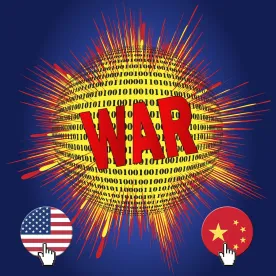Recent U.S. Trade Actions
Concerns about the possibility of a U.S.-China “trade war” remain strong, especially after the Trump administration announced (Section 201) safeguard decisions against imported solar panels in January, and the Commerce Department released its (Section 232) report in February on the national security impact of steel and aluminum imports recommending additional tariffs and/or quotas on both products. On solar panels, the United States will proceed to impose tariffs of 30 percent in the first year, gradually reducing tariffs to 15 percent in four years. This is expected to have an impact on specific Chinese companies, even if limited in terms of overall exports, as massive government subsidies have dramatically increased the production of solar cells and modules with China’s share of global solar cell production rising from seven percent in 2005 to 61 percent in 2012, according to the USTR.
In its February report, Commerce found that the quantities and circumstances of steel and aluminum imports “threaten to impair the national security,” as defined by Section 232, requiring the President to decide on its recommendations by April this year. These recommendations included a global tariff of at least 24% on all steel imports or a tariff of at least 53% on all steel imports from 12 countries, including China. Commerce also recommended a tariff of at least 7.7% on all aluminum exports from all countries, or a tariff of 23.6% on all such products from selected countries, including China and Hong Kong.
Additionally, the U.S. International Trade Commission (USITC) voted in January to continue anti-dumping (AD) and anti-subsidy duty (CVD) investigations against Chinese aluminum sheets that was self-initiated by the U.S. Commerce Department last November. In this case, Commerce is required to issue preliminary anti-subsidy duty determinations in February and anti-dumping duty determinations by April. Finally, USTR is expected shortly to announce the results of its Section 301 investigation against China’s policies and practices regarding technology transfer, intellectual property and innovation that could recommend broad sanctions against Chinese technology companies.
Apart from these trade remedy actions, the United States has also recently begun to scrutinize Chinese inbound investments, especially in the technology sector, in terms of their impact on national security. Congress held committee hearings in January to consider reform of the process for approving inbound foreign direct investments (Committee on Foreign Investment in the United States or CFIUS) with a focus on recent Chinese efforts to acquire U.S. technology companies.
China’s Response
As expected, China has responded in a “tit for tat” retaliation against U.S. exports to China.
In response to the U.S. safeguard action on solar panels, China’s Ministry of Commerce called the decision “an abuse of trade remedy measures” and took the case to the WTO. It also warned that China will “resolutely defend its legitimate interests.” Shortly afterwards, citing “special circumstances,” the Ministry of Commerce self-initiated an investigation into sorghum imported from the United States. (Note: 79 percent of U.S. sorghum exports reportedly went to China in the 2016-17 crop year.) A Foreign Ministry spokesperson indicated at a press conference that the probe was “just a normal case of trade remedy investigation” rather than a response to the recent U.S. safeguard actions. Later in February, China’s Commerce Ministry issued an initial ruling on styrene chemical dumping by U.S. and South Korean manufacturers, requiring importers to place anti-dumping deposits of 5-10.7 percent with Chinese Customs. (Note: U.S. styrene exports to China totaled more than $4 billion in 2017.)
More broadly, it appears that many Chinese officials believe that China has sufficient economic leverage to counter these trade actions by the United States. As the State-run newspaper Global Times warned in an editorial in late 2016, “Boeing orders will be replaced by Airbus, U.S. auto and iPhone sales in China will suffer a setback, and U.S. soybean and maize imports will be halted.” An industry representative who accompanied a bipartisan group of former senior U.S. officials (including NSC Advisor Stephen Hadley and Commerce Secretary Gutierrez) to Beijing in January characterized the Chinese response essentially as “both sides will lose to you’ll lose more.” (Reuters, January 19, 2018) As summarized by the Global Times: “Politically, the administration of President Donald Trump can’t afford to see China-U.S. economic and trade ties become strained. China is more resilient to a trade war.” (Global Times, Jan 18, 2018)
Nonetheless, Beijing sent State Councilor Yang Jiechi, China’s top foreign envoy, to Washington in early February to meet with senior U.S. officials to seek a resumption of high-level trade talks, among other issues. The Comprehensive Economic Dialogue (CED) held last July had ended without producing any substantive results nor a schedule for the next round of talks. In fact, the CED had concluded without the issuance of a joint statement. After the meeting between Yang and Secretary of State Tillerson, the two sides agreed to hold the next round of the CED “as early as possible” this year but did not announce specific dates.
Current Focus on the USTR Section 301 Investigation
At this point, attention is focused on how the Trump administration will decide on the two remaining outstanding U.S. trade actions specifically against China, i.e., the self-initiated AD/CVD investigation of Chinese aluminum sheet imports and, more consequentially, the ongoing USTR Section 301 investigation of Chinese IP policies and practices that are expected to be announced possibly within the next few months. Should the USTR recommend, and the President adopt, strong sanctions against Chinese companies that are seen as having benefited from the forced transfer or theft of U.S. intellectual property, the impact on Chinese technology-related imports to the United States is expected to be much broader and more significant than previous trade remedy actions. China has sought to make clear that its response to these anticipated sanctions in the critical technology sector will be equally strong, hence raising the risk of increasing trade conflicts between the two countries.
As in the past, U.S. business associations and others have also begun to warn about the risk of increased trade actions, underscoring the impact on U.S. companies and the economy as a whole. In a Wired magazine story in February, the author equated a trade war with China to the “Doomsday Clock” at two minutes before midnight. (Klint Finley, 2/8/2018, www.wired.com/story/a-trade-war-with-china-could-catch-tech-in-the-crossfire) It noted that 20 percent of Apple sales came from “Greater China,” including Hong Kong and Taiwan, while China consumes 29 percent of the world’s semiconductors, more than half of which are imported from the United States. It also quoted a spokesperson from the Information Technology Industry Council (ITIC), which represents a wide range of U.S. tech companies, as saying that “we strongly support the administration doing an investigation of Chinese tech policies and practices” but the U.S. “shouldn’t impose tariffs or other penalties on China” that would raise prices. Another report issued by The Heritage Foundation warned that “unilateral action risks a breakdown over trade with China, with a collapse having wide-reaching negative effects for the American economy.” (Riley Walters, “U.S. Needs to Address Chinese Trade Distortions, but Section 301 is Not the Way,” 1/22/2018) It added that “tariffs and sanctions on Chinese imports could also violate America’s commitments to the World Trade Organization” and urged Congress “to take the lead in establishing U.S. policy that can guide China into becoming a responsible economic partner.”
So the critical question now is whether the Trump administration will proceed to announce significant Section 301 sanctions despite retaliatory threats from China and pressure from many in the U.S. high-tech industry. Insofar as China has not yet taken any substantive steps to address the fundamental policy and structural issues underlying the U.S. investigation, it would be difficult – politically or otherwise – for President Trump not to announce sanctions without appearing to have backed down from his initial position and doing what he had publicly criticized former U.S. presidents for doing, i.e., not effectively challenging China’s unfair trade practices. It thus seems likely at this time that Trump will announce major sanctions as a result of the Section 301 investigations. The question then will be how China responds to these sanctions. If China responds as it threatens with broad actions against U.S. companies and agricultural products but does nothing to alter its IP and innovation policies, trade tensions are likely to increase sharply with major costs for both sides.




 />i
/>i

